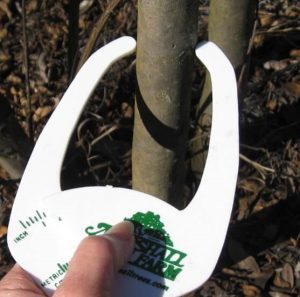We fit fruiting trees and vines in our landscape because the man of the mower enjoys eating food from the yard. We fondly recall our granddaughter’s first homemade cobbler, made with freshly picked blackberries. Good memories. A dear friend gifted us with two loquat trees. It may be a few years before we have production but we look forward to sharing that fruit. It is my joy to share a partial list of deciduous fruit and nut suitable for North Florida’s climate.
Deciduous trees shed most leaves each year, usually in autumn or winter. Our part of the world receives between 400 – 500 chill units annually, based on thirty year historical data. Chill unit is number of hours at or below 45 degree F. Based on what your family likes to eat, select varieties requiring 400-500 chill units.
Apple –Anna and Dorsett Golden cross pollinate with TropicSweet.
Fig – Celeste and Brown Turkey. Roots like to be cooler, benefiting from amended soils. Stems and branches receive full sun, 8+ hours direct light. Sap may irritant skin.

Peach – cultivar (chill unit) specific. Gulfking (350), Flordaking (350), Flordacrest (375), Gulfprince (400), Gulfcrimson (400), Gulfcrest (525). If you have space, plant one requiring less chill units and one requiring more. Are you a hands-on gardener? Do you like pruning on annual basis? With the tendency to set more fruit, thinning to space one every six inches along the branch is recommended.
Pear – Ornamental value when in bloom. Flordahome and Hood varieties have fine textured flesh. Conversely, sand pear contain grit cells which are noticeable when fresh but less so after canning.
Pecan – Two or more cultivars to overlap pollen shedding with female flower receptivity. Example Desirable (pollen source) and Elliott, MoneyMaker, Schley and Stuart (cultivar to be pollinated). See The Pecan Tree (EDIS HS982, rev. Jan 2019). Some years bearing heavy crop and some years not so much. More research is needed regarding alternate bearing habit.
Does the site receive eight hours direct light? How much room do you have for planting? Planting for mature tree size prevents branch and root conflict with house, foundation and walkways. Plant minimum 30 feet from septic or drain field. Use smaller maturing trees to avoid overhead powerline. Excess fruit and leaf litter may stain or become a nuisance. What will you do with extra fruit?
Coastal landscapes may be warmer, windier, receive salt spray and experience alkaline soils compared to inland of the same county. How may we include edibles in the coastal landscape? This provides opportunity for alternative edibles in containers. Dwarf cultivars grown in large sheltered containers and fruiting shrubs may be options.
Before you dig, call 811 to locate and mark underground utilities, pipes or cables.
This is a free service that may keep you safe, save costly repair and avoid interrupted service. Plan ahead, minimum two to three day lead time required from notification to start.
Dig a hole one to two times wider than root ball but no deeper. Retain soil. Roll container on side to loosen root ball. Ease the container off the rootball. Girdling roots circling the trunk should be cut. Rootbound roots bearing the imprint of container, should be trimmed at point of bend.
In sandy, well drained soils, locate and place uppermost root 1-2 inches above grade. In clayey, compacted or wet soils, place uppermost root 3-4 inches above grade and back fill to top of root ball. Replace soil, add water, gently firm. Native loose soil is recommended and allows roots to position in natural spreading fashion. If backfill soil differs from structure and texture from surrounding soils, water may be diverted from rootball and roots may not extend beyond the amended soils. If thoroughly blended, a 60/40 ratio of native to amended soils is acceptable. Incorporate into planting hole and sides of the hole. Keep top of root ball free of mulch or soil.
Not all trees require staking. Trunk flexing and slight bending should be allowed and is necessary for to develop trunk taper. Remove restraint once established.

Use leftover soil to build a 3-6 inch raised soil ridge outside root ball. Supply one gallon water for trees of less than two inch caliper, daily for two weeks. 2-3 times per week for 2 months. Weekly until established. Adjust watering to maintain moist but not saturated soil conditions. Keep grass and weeds two feet from trunk to reduce water and nutrient competition. Fertilization and care, month by month detailed here.
Insect, disease and wildlife pests vary. Some fruit trees and vines require time and effort in pruning, thinning and routine care. If possible, hold off till fall or winter to purchase and plant bare root trees and shrubs. Containerized trees may be planted year-round. Select trees with branches evenly spaced, free of wounds, scars or cracks. Good luck with that! Let me know how it goes. Until next time – Happy Gardening!
 0
0
